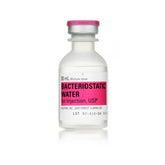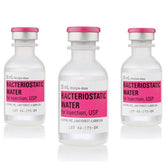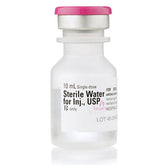Did you know that something as simple as water, when fortified with a tiny amount of a preservative, can become a cornerstone of medical safety? Bacteriostatic water, a term familiar to healthcare professionals yet often unheard of outside medical circles, embodies this transformation. It's not just any water—it's a lifesaver in a vial. This blog dives deep into the essence of bacteriostatic water, focusing on its preservative power that keeps injections safe across the globe.
Understanding Bacteriostatic Water
At its core, bacteriostatic water is sterile water rendered bacteria-free with the addition of benzyl alcohol, a preservative that wards off microbial growth. This special blend distinguishes it from plain sterile water used for injections, which lacks any antimicrobial agent. In the medical world, the ability to use a vial multiple times without the risk of contamination is a game-changer, making bacteriostatic water invaluable for diluting medications for intravenous, intramuscular, or subcutaneous administration.
Why does this matter? In settings where treatments require precision and safety, the choice of diluent can significantly impact both. Bacteriostatic water ensures that once a medication is reconstituted, it remains usable and safe for up to 28 days, offering flexibility and efficiency that is crucial in fast-paced medical environments.
The Science of Preservatives in Bacteriostatic Water
The magic ingredient, benzyl alcohol, does more than just inhibit bacterial growth; it ensures the integrity of the medication remains intact over time. How? By disrupting the life cycle of bacteria, benzyl alcohol keeps these unwanted guests at bay, making bacteriostatic water a safe medium for medication administration. The concentration of benzyl alcohol is meticulously calculated to balance efficacy with safety, ensuring it's strong enough to prevent microbial growth but gentle enough for human use.
This scientific balancing act is crucial for patient care, allowing healthcare providers to confidently use bacteriostatic water in a variety of treatments, from managing chronic conditions to responding to acute medical needs.
Advantages of Using Bacteriostatic Water
The benefits of bacteriostatic water extend beyond its antimicrobial properties:
- Extended Shelf Life: Unlike sterile water, which is a one-and-done deal, bacteriostatic water can be used for up to 28 days after opening, reducing waste and saving costs.
- Versatility: It's a jack-of-all-trades in the medical field, suitable for diluting medications for various routes of administration.
- Economic Efficiency: By minimizing waste and extending usability, bacteriostatic water proves to be a cost-effective choice for healthcare facilities.
Safety Considerations and Limitations
Despite its benefits, the use of bacteriostatic water is not without cautions. The presence of benzyl alcohol means it's not suitable for all populations, particularly neonates, where the risk of toxicity is higher. It's a reminder that even the most beneficial medical substances require careful consideration and respect for their potential risks.
Healthcare providers and patients alike must be educated about these limitations, ensuring that the use of bacteriostatic water is both safe and effective. Knowledge is power, especially when it comes to navigating the complexities of medical treatments.
Regulatory Oversight and Quality Assurance
In the quest for safety, bacteriostatic water undergoes rigorous regulatory scrutiny. Agencies like the FDA and EMA set stringent standards for its production, ensuring that each vial meets the highest levels of purity and safety. This oversight is a testament to the commitment to patient care that underpins the medical industry, guaranteeing that the bacteriostatic water used in treatments is of the highest quality.
Purchasing from reputable sources is key, as it ensures compliance with these standards, safeguarding against the risks of counterfeit or contaminated products.
Best Practices for Healthcare Providers and Patients
To harness the full potential of bacteriostatic water, adhering to best practices is essential:
- Storage and Handling: Proper storage conditions and adherence to the 28-day use window are vital for maintaining its safety and efficacy.
- Patient Education: Informing patients about the correct use and potential risks associated with bacteriostatic water can empower them in their care journey.
Summing Up: The Critical Role of Preservatives in Bacteriostatic Water
Bacteriostatic water is a silent sentinel in the realm of medical treatments, its preservative powers safeguarding the efficacy and safety of countless injections. It's a reminder of the innovation and care that define modern healthcare, ensuring that even the simplest elements are optimized for patient safety. As we continue to advance in medical science, the role of bacteriostatic water remains steadfast, a testament to the power of combining nature and science for the greater good.
We invite you to share your thoughts and experiences with bacteriostatic water in the comments below. Whether you're a healthcare professional or someone interested in the intricacies of medical science, your insights can help illuminate the importance of this unsung hero in healthcare.
For more informative content on healthcare practices and innovations, stay tuned to our blog. Together, let's keep the conversation going, fostering a community of informed and engaged healthcare advocates.











